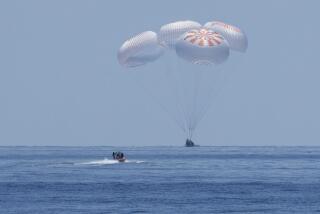Navy Building Pad for High-Tech Landing Vehicle
- Share via
CAMP PENDLETON — It looks like something custom-made for Luke Skywalker, but this vehicle is stamped “Made in the U.S.A.,” and it’s designed to skim across waves, not weave through solar systems.
They call it the LCAC--for Landing Craft, Air Cushion. And one day soon, the high-speed, high-tech, ship-to-shore amphibious assault vehicle will be buzzing the beaches on Camp Pendleton.
There, on a desolate stretch of land between Interstate 5 and the surf, the Navy is building the world’s first training center for the craft and its crew. The $55-million facility will by the end of 1986 house six of the vehicles, described by American military leaders as providing a “revolutionary dimension to amphibious warfare.”
Passers-by traveling on Interstate 5 can see the construction under way. Sloping earthen berms with thick concrete-slab walls surround a paved training ground roughly the size of four square football fields, and a cement ramp stretches down to the sea. A control tower with a giant antenna, a warehouse, a fuel storage area, fire station and administrative offices will round out the complex when construction is completed in the mid-1990s.
Cpl. Mike Badon, a Camp Pendleton spokesman, said the massive walls are designed to contain the noise and flurries of sand generated by the 160-ton landing vehicles, which are essentially military-equipped hovercraft.
“There’s a tremendous amount of power used to make this thing hover, so it’s not surprising that it kicks up a lot of dirt and makes a lot of racket,” Badon said.
In fact, the noise is so great that Coronado city officials protested three years ago when the Navy proposed building the LCAC base at the Coronado amphibious training complex. They said the use of the craft on Navy-controlled beaches along the Silver Strand would violate the city’s noise ordinance and disturb nearby residents.
The protest prompted Navy officials to drop their plans and pick the Camp Pendleton site. Nevertheless, they intend to perform some exercises with the LCAC along the Strand. Ray Silver, Coronado’s city manager, said, “We’ll be watching--and listening--very closely and can only hope the Navy will be sensitive to our concerns.”
Manufactured in New Orleans by Bell Aerospace Textron, a division of Textron Inc., the LCAC is 88 feet long by 47 feet wide and capable of carrying a 60-ton payload--tanks, troops, trucks or other equipment, said Jack O’Brien, Textron’s director of marketing in Washington.
Powered by four gas-turbine engines that turn two four-blade, 12-foot propellers, the vehicle can travel at more than 40 knots on calm seas--five times as fast as any of its predecessors.
But the LCAC’s most impressive feature is its ability to ferry troops and equipment as far as 10 miles inland.
“Previously, landing craft have had to ground out on the beach, depositing troops and equipment in shallow water,” O’Brien said. “With its cushion of air, the LCAC lands its Marines and tanks high and dry. It’s a truly amphibious vehicle.”
The craft can clear obstacles as high as four feet and can safely traverse ditches, gullies, sand dunes, marshland and other terrain, O’Brien said. A flexible skirt made of nylon and rubber surrounds and retains the continually generated four-foot cushion of air, which lifts the vehicle off the ground and water.
Badon said the hovercraft “greatly enhances” the Marines’ amphibious attack, allowing troops to “assault 70% of the world’s shoreline, as opposed to the 17% that is now accessible to us with conventional landing craft.”
“This is the state-of-the art in the Marine Corps,” Badon said. “It would have made all the difference in some historic landings, where commanders were limited by tides and bad terrain.”
Gen. Paul X. Kelley, the commandant of the Marine Corps, has called the LCAC “the most significant advance in warfare since the introduction of the helicopter.”
The LCAC is being tested at the Naval Coastal Systems Center in Panama City, Fla. By July, 1986, the first six craft and their crew, the Navy’s Assault Craft Unit 5, will arrive at Camp Pendleton. Eventually, a second training base for the LCAC will be built in Little Creek, Va.
Although construction of the base is a feather in the cap for Camp Pendleton, it troubles state Coastal Commission officials, who granted what is called a “consistency determination” with reservations in early 1983.
(Federal agencies that wish to build in the coastal zone are required to review their project for consistency with California’s coastal program. The agency then submits its consistency determination to the commission, which conducts its own review and either agrees or disagrees with the federal finding. Disagreement leads to further negotiations or ultimately a court battle.)
Mary Hudson, staff counsel for the commission in San Francisco, said the LCAC and its base “pose significant environmental problems,” largely because the endangered California least tern and several other threatened birds nest in the area.
“The commission agreed that the project is consistent with the Coastal Act contingent upon the Navy meeting certain stipulations,” Hudson said.
Conditions imposed on the Navy included restoration work in a canyon battered by years of maneuvers, limited operations during least tern nesting season, erosion control measures to limit runoff into the nearby Santa Margarita River estuary, and initiation of an environmental monitoring program through 1995.
The monitoring program involves the commission, the state Department of Fish and Game and the U.S. Fish and Wildlife Service, and will gauge the impact of base operations on plant and animal life.
More to Read
Sign up for Essential California
The most important California stories and recommendations in your inbox every morning.
You may occasionally receive promotional content from the Los Angeles Times.













